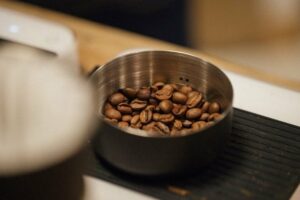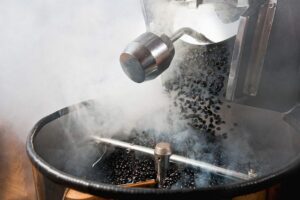Basics of Coffee Roasting: Flavor Development Through Roasting
Roasting is probably something that every barista wants to learn about! We can enhance the flavour of coffee by roasting it. How can we make the best-tasting coffee possible? What happens when you roast something?
What is the significance of roasting – or is it?
Coffee beans are developed seeds from coffee cherries. After that, they’re processed and dried to become coffee beans. Coffee beans are green in colour and have a beany, grassy scent before being roasted. Green coffee beans, on the other hand, do not smell like coffee at all. We produce 800 to 1000 different fragrance molecules when we roast coffee. The coffee’s flavour is created by these components. We can influence the presence of these aroma components in coffee and also identify the flavour of the coffee using roast profiling.
The roasting of coffee
Roasting refers to the process of turning green coffee beans into brown ones. It can be made in a variety of methods, which influences the flavour. I’ll go over the fundamentals of roasting and industrial roasting here. Tomi’s blog discusses the many methods for roasting coffee at home.
Stages of Roasting
The drying, browning, and development (or roasting) stages are the three primary steps of roasting.
STAGE 1: DRYING
The coffee bean has an average humidity of 8–12%. Before we begin roasting, we must first dry it. With a classic drum roaster, the drying stage usually lasts 4–8 minutes (see below for roaster designs). The temperature at the end of the drying step is usually around 160 degrees Celsius. You must be careful, especially with drum roasters, to avoid burning the beans by using too much heat at the start. Because the final act of roasting is exothermic, the drying stage is also vital for gathering energy for the bean (heat producing).
STAGE 2: BROWNING
The coffee begins to smell like toasted bread and hay after it reaches 160°C. This is the point at which the fragrance precursors begin to transform into scent molecules. Despite the fact that the browning step occurs after the drying stage, the drying process continues during the browning stage.
The Maillard process, which causes browning, begins during the browning stage. Reducing sugars and amino acids combine in the Maillard reaction to produce hundreds of distinct flavour and colour chemicals known as melanoids. This is the point at which the roast naturally slows down – and some roastmasters prefer it to do so – to allow for flavour development. The coffee begins to pop at the end of the browning cycle. This is known as the first crack, and it is at this point that the development stage begins.
STAGE 3: OF DEVELOPMENT OR ROASTING
The reaction becomes exothermic at the start of the growth stage, and the coffee cracks. The bean has accumulated energy during the drying and browning steps, which causes the coffee to erupt. When the desired scent compounds are developing, it is called development period. We can easily get coffee that tastes smokey and has a strong flavour if we do not slow down the roast during the development stage.
Depending on the intended flavour profile and roast degree, the development stage might last anywhere from 15 to 25% of the entire roast time.
Degree of Roasting
The roasting degree is one of the most essential indicators. A colour metre or a taste test can be used to determine it. Roasters usually strive to bring out the natural flavours of coffee and determine the degree of roasting. Lightly roasted coffees are typically more acidic, whereas darkly roasted coffees are bitter. Light roasts are also more likely to have fruity flavours, whilst dark roasts are more likely to have roasty and burnt flavours. Due to high levels of an organic component called 5-hydroxymethylfurfural, light roasted coffee has a more fruity flavour. As the roasting progresses, this molecule degrades into less fruity chemicals. The number of sulfuric chemicals in the food increases, resulting in roasted and burnt flavours. We can infer that light roasted coffee brings out the character of the raw coffee better as a rule of thumb. Dark roasted coffee is more difficult to distinguish from light roasted coffee.

It’s time to roast.
Even while the roast degree has the greatest impact on the flavour profile of coffee, the overall roast time and the time spent at each step are also critical. If you roast quickly, you’ll receive more of the fragrance components you want. But take cautious not to overcook the beans! The overall flavour of coffee (fruity, berry-like, chocolaty, and nutty) is greater. Fast roasting also increases the number of fragrance components formed at the start of the growth stage.
Fast roasting isn’t always the best option. It could be related to the roaster’s design (see next paragraph) or the properties of the coffee. Fast roasting brings out all of the coffee’s flavours. We must change the roast profile if we do not want some flavours in the coffee. Acidity, for example, is typically a preferred flavour, but in espresso mixes, minimal acidity is occasionally requested. Slower roasting allows organic acids to break down more slowly, making the coffee less acidic. This is when slow roasting comes in handy.
Roaster layouts
Roasters come in a variety of shapes and sizes. The design has an impact on the thermodynamics of roasting, and different equipment can produce different flavours of coffee. Drum roasters are commonly used by small roasters, in which beans rotate in a drum heated below with either a direct or indirect flame. As a result, the energy volume of roasters is large. Although roasting using these devices is quite steady, the roastmaster must be able to think up to minutes ahead of time. When roasting slowly, drum roasters are recommended since a high temperature at the start of the roast might burn the bean from the outside. We employ a conventional drum roaster – Bertha roaster – which is a Probatone 5 coffee roaster in Paulig Kulma.
Fluidized bed roasters have been around for a long time in the industry. The roaster in a fluidized bed roaster is heated indirectly by hot air. As a result, the roaster is easier to control. Fluidized bed roasters allow for faster roasting without burning the bean from the exterior, as well as greater scent in the coffee. Our roaster in the Vuosaari roastery is an example of a fluidized bed roaster. There are other hybrids of fluidized bed and drum roasters, such as Loring Roasters, which have a drum but heat through hot air indirectly.

Are you roasting for filter coffee or espresso?
Have you ever wondered what the distinction is between filter and espresso coffee? Filter extraction is done by gravity and is a very gentle procedure. For the filter, you might choose a more aromatic and acidic coffee. Espresso, on the other hand, is extracted at a pressure of 9 bar. More flavour is extracted into the cup as a result. Coffee roasted for espresso may not be as delicious as filter coffee when brewed, and vice versa. Some roastmasters choose to roast just for the bean, rather than for the extraction process, which implies aiming for a golden medium between too light and too dark so that coffee can be used for both.
Espresso is traditionally a dark roasted coffee with a high body and low acidity. Different countries roast filter coffee differently, but the roast level is often lighter than espresso. Roasting styles are more varied nowadays than they were in the past. For example, our Ethiopia Amaro Gayo espresso placed third in the espresso category at the Helsinki Coffee Festival. The espresso was light roasted with a quick profile, resulting in a highly aromatic product with a minimal level of roastiness. The body was juicier than hefty. On the other hand, we want some of our espresso coffees to be more full-bodied. Then, to develop flavour and reduce acidity, we roast for a little longer and extend the development stage.
Overall, mastering the art of roasting is a never-ending quest. It’s never too late to learn more about the bean. The most fascinating aspect of my job is determining the appropriate roast profile for the coffee’s attributes. I hope you found the information useful and that it aided you on your coffee adventure!






